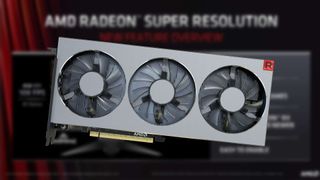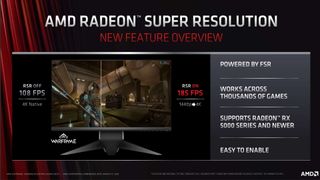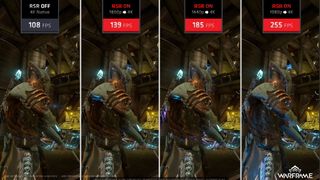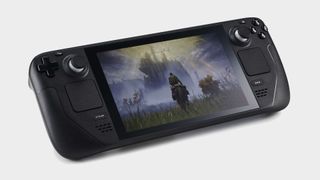AMD is 'evaluating' whether to enable Radeon Super Resolution on older GPUs
But there's no guarantee and AMD's Ryzen 6000 chips and laptop GPUs are first in line in Q2 of this year.

AMD has said it's going to be "evaluating" whether your RX 580 deserves Radeon Super Resolution (RSR). But it's only going to be doing that once it has gotten the new performance boosting feature playing nice with its Ryzen 6000-series APUs (those with RDNA iGPUs) and then with Radeon-powered gaming laptops.
So, you're a little way down the priority list, but at least it's not a hard 'no' to RSR hitting older AMD graphics silicon. Gotta take the positives where you can find them right now, eh?
AMD has only just released Radeon Super Resolution, a software based upscaler that's powered by FidelityFX Super Resolution (FSR), but doesn't require devs to pre-bake support into their games. That means almost any game will benefit from higher frame rates if you run RSR and your games at a lower resolution than that of your native screen.
It's effectively the same solution Valve has stuck into the Steam Deck to allow it to upscale to a 1080p docked display without sacrificing the performance it's capable of at 800p.
The catch right now is that RSR is only available in drivers for Radeon RX 5000-series GPUs and above. That means anyone sporting an older GCN-based GPU, such as the popular RX 400- or 500-series—or even the ill-fated Radeon VII—is out of luck.
That's a shame given that RSR's more powerful progenitor, FSR, is fully supported on all those graphics cards, so long as the game has it. But that doesn't mean RSR will never find its way onto older GPUs, it's just that it's at the back of the queue.

Speaking at the press briefing for the new Radeon software, Glen Matthews, AMD's director of software management, said that:
The biggest gaming news, reviews and hardware deals
Keep up to date with the most important stories and the best deals, as picked by the PC Gamer team.
"Our next step is with the Ryzen 6000 RDNA products, so we'll be adding that capability, that's going to be in Q2. And then after that will be support for hybrid solutions, so where you have Ryzen 6000 with a Radeon product added in… a discrete solution in your laptop.
"We are evaluating other solutions after that. The reason we've taken that process is both a combination of what we see from our users in terms of the displays that they use, and then also where we see most value to our users. And we prioritise in that order."
The issue, however, is whether AMD will actually see value in adding support to folk with an RX 570 plugged into a 1080p display. Will it decide that RSR upscaling from 720p to 1080p will result in too muddy an image to be worthwhile? There is certainly something in that wording to intimate a relationship between screens and the value proposition of RSR.
Our next step is with the Ryzen 6000 RDNA products, so we'll be adding that capability.
Glen Matthews, AMD
Valve obviously does, because that's exactly what the Steam Deck does. In fact it can go further—I've had Elden Ring running on its highest settings rendering at some godawful 16:10 resolution and upscaling to 800p using its implementation of RSR. I mean, it doesn't look good, but it sure runs well.
That's also how Valve envisions docked gaming to work going forward, with Deck gamers running at 720p, or the native 800 res, and upscaling to 1080p on a connected monitor.
The Deck is running an RDNA-based GPU in its Aerith APU, however, so it doesn't need to rely on AMD making the call over whether that's a valid use of its new software feature. Though admittedly AMD likely helped Valve with the implementation in the first place, so it will be aware of its utility, especially on lower spec hardware.


Steam Deck review: Our verdict on Valve's handheld PC.
Steam Deck availability: How to get one.
Steam Deck battery life: What's the real battery life of the new device?
How loud is the Steam Deck? And will it pass the Significant Other test?
Steam Deck - The emulation dream machine: Using Valve's handheld hardware as the ultimate emulator.
That combination of AMD graphics and a Linux-based operating system does mean that if you're sporting a GCN-based GPU there's a chance of RSR support right now. Some users are reporting that simply by using the latest RADV drivers (the ones used on the Steam Deck) and running Gamescope/Proton, you actually get a pretty good experience using Radeon Super Resolution with a Graphics Core Next graphics card.
It has to be said, however, that I haven't tried that combo myself, so cannot speak to actually how well it works. Or how easy it is to implement. But hey, you could make the switch if you're really desperate to get RSR running on your RX Vega 64 (🤭). Or maybe wait for SteamOS 3.0 to be fully released.
But, whatever the Linux situation, fingers crossed it's just a matter of time before AMD proudly proclaims support for your old school Radeon graphics card in a future update on the Windows side. It just won't be anytime before the summer, that's for sure.

Dave has been gaming since the days of Zaxxon and Lady Bug on the Colecovision, and code books for the Commodore Vic 20 (Death Race 2000!). He built his first gaming PC at the tender age of 16, and finally finished bug-fixing the Cyrix-based system around a year later. When he dropped it out of the window. He first started writing for Official PlayStation Magazine and Xbox World many decades ago, then moved onto PC Format full-time, then PC Gamer, TechRadar, and T3 among others. Now he's back, writing about the nightmarish graphics card market, CPUs with more cores than sense, gaming laptops hotter than the sun, and SSDs more capacious than a Cybertruck.
Most Popular






